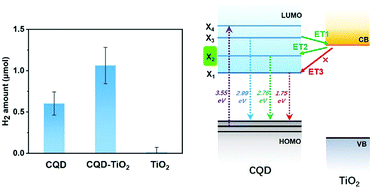Enhanced light-driven hydrogen generation on carbon quantum dots with TiO2 nanoparticles†
Abstract
Solar to hydrogen (H2) conversion systems based on carbon nanomaterials have shown great potentials in the clean energy field recently. However, for most systems, energy level alignments and light-induced redox processes are still unclear, which hinder artificial designing for higher efficiency of solar energy conversion and further applications. Here we report 77% enhancement in the light-driven H2 generation efficiency of N,S co-doped carbon quantum dot (N,S-CQD) aqueous system by adding TiO2 nanoparticles. Using steady-state and transient spectroscopy, four specific energy levels of CQDs are confirmed with the band gaps of 3.55 eV (X4), 2.99 eV (X3), 2.76 eV (X2) and 1.75 eV (X1), respectively. The X2 energy band is highly active for H+ reduction with a longer lifetime of 13.38 ns. Moreover, the observed low efficiency of intrinsic transition from X3 to X2 band of N,S-CQDs accounts for the poor performance of solar to H2 conversion for pure N,S-CQDs based on H2 generation and detailed time-resolved spectroscopic results. The mechanism of H2 generation enhancement can be explained by multiple electron transfer processes between N,S-CQDs and TiO2 NPs where TiO2 NPs act as electron intermediates that efficiently transfer electrons from the inert band (X3) to the active band (X2) for H2 generation. This study enriches the fundamental understanding of N,S-CQDs and provides a new pathway toward high-performance N,S-CQD-based solar to H2 conversion systems.



 Please wait while we load your content...
Please wait while we load your content...